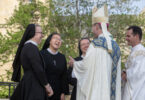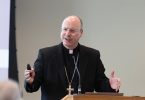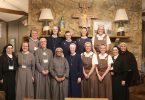
Sister Teresa Maya, CCVI, from San Antonio, gave one of the keynote addresses of the 2015 national gathering of Giving Voice, an organization of women religious age 50 and younger. She spoke about the tremendous demographic changes within religious congregations around the world and the possible ways congregations and women religious will live out their charisms and vocations. Photo by Joe Bollig.
by Joe Bollig
joe.bollig@theleaven.org
KANSAS CITY, Kan. — For quite some time now, it seems like the story of women religious has been told by Sister Debbie Downer.
You’ve heard “The Downer Report” before: fewer vocations, shrinking and aging congregations, the high cost of care for aging religious and the difficulty of maintaining older ministries such as hospitals and schools.
It’s all true — but not the complete truth.
If you had been at Savior Pastoral Center in Kansas City, Kansas, from Aug. 6-9, you would have seen something different: happy, laughing and optimistic young Sisters.
More than 60 Sisters, from congregations across the United States, were part of the 2015 national gathering of the organization Giving Voice.
Giving Voice is described as “a peer-led organization that creates spaces for younger women religious to give voice to their hopes, dreams and challenges in religious life.” The theme of the gathering, for Sisters age 50 and younger, was “Crossing Boundaries.”
These younger Sisters are coming to the fore in a time that will bring profound changes to religious communities in the next decade. They’re eager pioneers of new models of religious life.
“It’s kind of like a reptile that has to shed its skin,” said Sister Rejane Cytacki, a Sister of Charity of Leavenworth and one of the six gathering organizers.
“That is where we are,” she continued. “We’re in that process where the old is coming off and something new is emerging. We have to be open to it and realistic as to what our reality is, and that’s where Giving Voice is a new vehicle to help us move forward.”
Crossing boundaries
The three-and-a-half day event featured opportunities for Mass, prayer, discussion, social time and listening to keynote speakers.
The theme of “Crossing Boundaries” related to one of the key concepts presented at the gathering: the concept that women religious currently live in a “liminal space.” It comes from the Latin word “limen,” which means “threshold.” The Sisters have a sense that they are now crossing the threshold of a new reality.
“We are in a liminal space right now as women religious in the United States and the world,” said Sister Rejane. “There are fewer of us who are on the younger end of the spectrum, and it’s vitally important that we build our relationships so we can move into the future together. And that has to happen through collaboration.”
Keynote speaker Sister Teresa Maya, CCVI, from San Antonio, asked this question: “How many of us were born outside of the United States?” At least one-third raised their hands.
That demonstration drove home an important point — that the communities of women religious are moving from cultural, racial and linguistic homogeneity to diversity, just like the rest of the United States and the world.
The United States is the top migrant destination in the world, particularly from Latin America, she said. In America, Sunday Mass is now celebrated in 87 languages.
“We’re becoming people of color,” said Sister Teresa, who spoke in Spanish. “We’re becoming a little ‘browner’ in Europe, and North America, and the whole United States. The Catholic Church is the most diverse of the whole world. What does it mean that the Catholic Church is the most diverse in the whole world? What does it mean to be religious in this diversity?”
The religious congregations are changing because the world is changing — and changing rapidly. The assimilation model of religious life, she said, is over.
No longer ‘the machine’
In addition to the demographic reality of increasing diversity, young women religious face two more realities.
One reality is that younger women religious are only 10 percent of the whole population of women religious.
“We are a little point,” said Sister Teresa. “We are very few.”
Still another reality is that women religious live in a time when five generations are alive at the same time. Each one of these generations is very different from the others in terms of experience, background, expectations and modes of ministry and religious life.
“What will have to change?” said Sister Teresa. “We can’t be pieces of a machine that was religious life, this religious life that was institutionalized in the 1950s and 1960s. But it was machinery that needed a lot of pieces to work. We can’t be the pieces to that machine. Sisters, we’re killing each other trying to be pieces of that machine.”
The future will be . . . ?
What religious congregational life will be in future is still unknown, but the outlines can be seen.
“Western, middle-class and white religious need to refrain from distilling religious life and Gospel values only from the American culture,” she said.
The future will likely be very “inter” — intercongregational, intergenerational, intercultural and international. Collaboration will be a key value.
“I really appreciated the fact that [Sister Teresa] spoke about the need to be intergenerational,” said Sister Maria Clara Kreis, CDP, who came to Pittsburgh from Germany 12 years ago. She is a licensed psychotherapist and teaches at Duquesne University.
“It’s not about the young people doing it. It’s about intergenerational, because the history of religious life has always been about generational,” she continued. “We need each other, but we need to listen to each other. Being in a minority as younger women religious, we need to also be listened to and our voices need to be integrated.”
Sister Clara also appreciated Sister Teresa talking about the intercultural aspect of evolving religious life.
“I don’t think it’s going to be bilingual or bicultural, just because Spanish is becoming [a more prominent] language in North America, since religious life is international,” said Sister Clara.
“As we become smaller, we will have to work internationally and get to know each other internationally,” she continued. “So I think we need to watch in North America that we don’t become bicultural because Spanish is maybe becoming a first language in [some areas of] the United States. I think we have a responsibility to the world and also to Europe.”
Trusting God will be the key as women religious begin to innovate new modes, said Sister Rejane.
“That’s where God comes into this whole equation,” she said. “I do believe that our vows, our virtues, our charisms and our values are adaptable enough to move us in this ever-evolving world.”
“Trust in God gives you the energy to move forward in the hope that whatever evolves out will be something of value and still have the spirit of our charisms,” said Sister Rejane.






